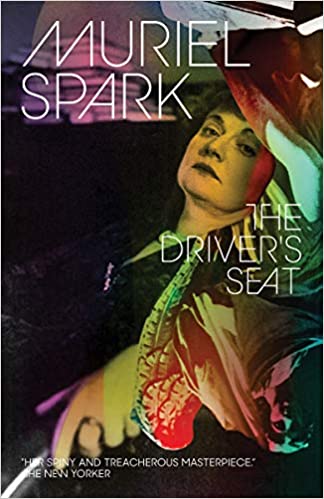Books |
The Driver’s Seat
Muriel Spark
By
Published: Dec 07, 2020
Category:
Fiction
HOW MURIEL SPARK WRITES: A video. Less than a minute long. Hilarious. To be shared with friends who agonize over a single paragraph. Click here.
There is no writer more despicable than the reviewer who spoils a book by revealing significant plot points.
But what do you call a novelist who begins the third chapter — the third chapter — of her book with this about Lise, the main character:
She will be found tomorrow morning dead from multiple stab wounds, her wrists bound with a silk scarf and her ankles bound with a man’s necktie, in the grounds of an empty villa, in a park of the foreign city to which she is traveling on the flight now boarding at Gate 14.
Try this: genius.
“The Driver’s Seat” is just 126 pages. It will take most of you about an hour. But in that hour, you are in for an experience even more head-splitting than you’ll get from Jim Thompson’s aptly named The Killer Inside Me.
Because — obviously — this book is about something considerably trickier than who-gets-killed.
So the first brilliance of Muriel Spark’s writing is its stunning originality; this is a book that really makes sense only backwards, when you finally have all the information to understand what happened. A close second is the writing. “Surgical” is often used to describe Spark’s prose, and in this, her most unsettling novel, you can see why. [To buy the paperback of “The Driver’s Seat” from Amazon, click here. For the Kindle edition, click here.]
In a line here, a line there, we learn that Lise is 34 years old. She lives in the north of Europe, perhaps Sweden. She has worked in an accounting office since she was 18, with the exception of “the months of illness” — and from the clothes she buys in the opening chapters and her strained, off-balance encounters with other people in the first few pages, we clearly get she’s had a breakdown and is now having another. She lives alone. She’s no oil painting:
Her lips, when she does not speak or eat, are normally pressed together like the ruled line of a balance sheet, marked straight with her old-fashioned lipstick, a final and a judging mouth, a precision instrument, a detail-warden of a mouth; she has five girls under her and two men.
A dull woman? That’s just the point. You’d never notice her, but on the last day of her life, you’d certainly feel her — and you’d find her really creepy. The customers in a clothes store feel her; she makes them “gasp and gape”. Her co-workers sit, silently, as she tells them, through hysterical laughter and tears, that her vacation will be “the time of her life.” And on the plane that takes her south, presumably to Italy, she so terrifies the man next to her that he bolts out of his seat.
On and on it goes, a nightmare of inappropriate conversation, off-putting behavior, fevered action. She’s supposed to have a date with her dream man — where is he? “The torment of it,” Lise says. “Not knowing exactly where and when he’s going to turn up.”
What’s going on here? Is this a thriller? A search for the dream man that suddenly veers from romance to violence? There are cops jumping in from time to time — is this a detective novel?
All of the above. And more. With a resolution you don’t see coming and then can’t see how it could have ended any other way.
“The Driver’s Seat” was published — as “a metaphysical thriller” — in 1970. Spark was already a literary powerhouse, thanks to The Prime of Miss Jean Brodie, her 1962 novel about a spinster schoolteacher in Edinburgh, Scotland. It had been published — in its entirety — in The New Yorker. On stage, it starred Vanessa Redgrave. Completing the triumph was the 1969 film, starring Maggie Smith, who won an Oscar for best actress in the title role.
“The Driver’s Seat” was immediately recognized as a new kind of book: a traditional, last-day-of-life narrative, told with unfamiliar brevity and objectivity. Spark wrote more than twenty novels; this was one of her favorites. And her most prescient: you can see the accuracy of this close study of alienation and dislocation on the faces of untold people walking on any street. Or just watch the quirky, disturbing movie version of The Driver’s Seat — with Elizabeth Taylor in the leading role and Andy Warhol in the cast.
Muriel Spark wrote her novels in composition books, using one side of the page. No typewriters or computers for her — she preferred pens that were not just new, but never touched by others. Rewriting? To her, that was the pastime of hacks; she rarely revised.
“The Driver’s Seat” is proof she didn’t need to.


